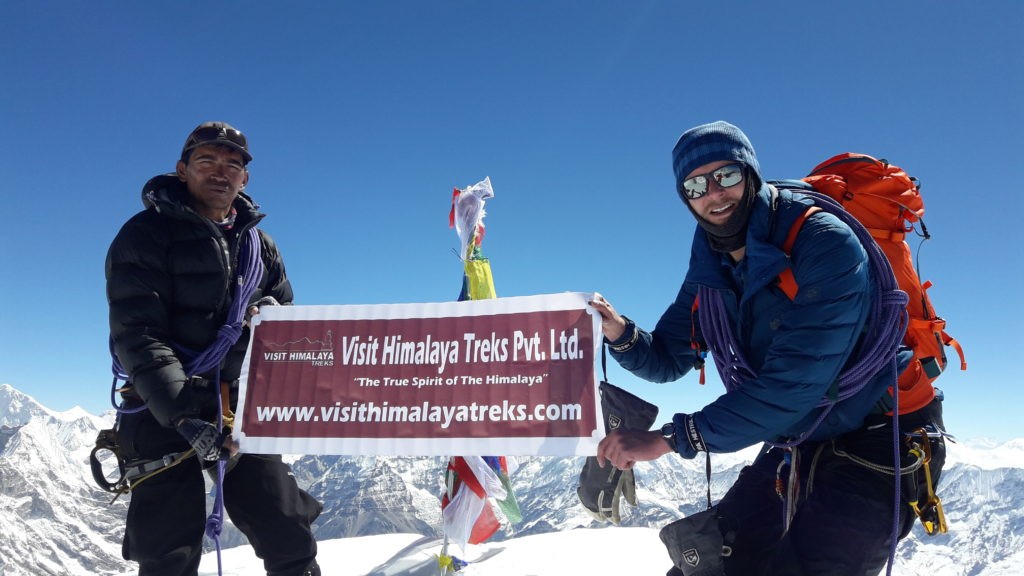Everest Three Peaks Climbing combines three great peaks including the highest trekking peak in Nepal Mera Peak 6476 meters, one of the most popular trekking peaks in the Khumbu region Island Peak (6189 meters) also known as (Imja Tse) and one of the most challenging trekking peak climbing Lobuche East peak (6119meters) trip to Everest region.
Everest Three Peaks Climbing offers the best possible introduction to mountain climbing- we summit three beautiful 6,000m+ peaks that Visit Himalaya Treks carefully design the itinerary to acclimatize and to make challenging high pass Amphu Labtsa pass 5845 meters and the best possibilities to summit each peak.
The Everest Three Peaks Climbing trip is an ambitious (challenging) trip that combines trekking and Climbing. Therefore you should be very well trained and have some experience with mountaineering in high altitudes. Trekking requires a performance above the average relating to force and endurance. Especially the summit day will be long and exhausting.
With respect to the technical alpine skills, you should have security in your steps and be free from giddiness. Even in bad weather, you should be able to walk safely on your own through difficult terrain like screes, rocks, and as well as on flat glaciers. Security in your steps means walking on exposed trails where a fall has fatal consequences. As you will sleep a few nights above the altitude of 4000 meters up to 5800 meters, very good health is required.
Mera Peak Climbing (6,476m)
Mera Peak, the highest trekking peak in Nepal comprises a non-technical route and is do-able for any avid climber who has strong determination and fitness level. It is the first peak among three peak climbing trails. Summit features an astounding view of Mount Cho Oyu, Everest, Lhotse, Nuptse, Makalu, Kanchenjunga, and several other peaks.
Island Peak Climbing (6,189m)
Island peak climbing is a moderately technical trekking peak among Everest's Three Climbing Peaks. The climbing route follows a series of scramble rocks, steep approaches, ice, ridge, and glaciers. Summit releases a great view of Everest, Nuptse, Lhotse, Ama Dablam, and surrounding peaks.
Lobuche East Peak Climbing (6,119m)
Accept the challenge of the toughest and most technical trekking peak at the end of the Everest Three Peak Climbing trip – Lobuche Peak Climbing. We ascend through the scramble of rocks and steep slopes full of technical sections. Although challenging, the summit exhibits a stunning view of the glistering mountains range of the Khumbu region including gigantic Mt.Cho Oyu, Pumori, Everest, Nuptse, Lhotse, Ama Dablam, Thamserku, Tabuche Peak, Chola Tse and several other peaks.
Why are Everest Three Peaks Climbing with Visit Himalaya Treks?
Visit Himalaya Treks put to experience a climbing guide and a strong team to make a successful ascend and grow your alpine climbing skill and arrange all the logistics for completion of the trail in comfort manner with high-quality gears. The Everest Three Peaks Climbing trip is one of the most challenging Peak climbing trekking Holidays in Nepal, Visit Himalaya Treks design the Everest Three Peaks Climbing trip itinerary very carefully giving maximum time to get acclimatize.
We Visit Himalaya Treks and provide an experience Climbing Guide who has summited Mera Peak, Island Peak, and Lobuche East Peak and a strong Supporter team. For such a challenging high trip it is very important to have the proper gear for the supporter’s team, like a Sleeping bag, Jacket, trousers, gloves, and shoes that are very important such a type of high altitude treks.
Lukla Flight Information.
Kathmandu Airport and the runways are shared by both domestic and international flights. Can be quite busy in the high tourism seasons, where Lukla flights will be in the peak time. To avoid the busy air traffic and landing on the runways can be a problem.
Completing the flights and making sure all travelers are in Lukla and Outing from Lukla on time. The Lukla Flight operates from Manthali (Ramechhap) Airport during the peak season. The months of October and November are in the autumn season and the months of March to May are in the Spring season Lukla flights operate from Manthali (Ramechhap Airport).
During this period (October and November in the autumn season and March to May in the Spring season) there is no flight available KTM – LUKLA and LUKLA – KTM.
During peak tourism season, October and November in the Autumn season and March to May in the Spring season Lukla flights operate only from Manthali (Ramechhap Airport).
Scenic Flight to Lukla Airport Full Information read here.
Everest Three Peaks Climbing Trip Itinerary:
Day 01: Arrive in Kathmandu (1350 meters).
Day 02: Sightseeing and Trek Preparation.
Day 03: Fly to Lukla (2850 meters) and trek Paiya (Chutok 2730 meters).
Day 04: Trek to Pangkongma (2,846meters)
Day 05: Trek to Nashing Dingma (2,600m)
Day 06: Trek to Chalem Kharka (3,600m)
Day 07: Trek to Khola Kharka (4,200m)
Day 08: Acclimatization day at Khola Kharka.
Day 09: Trek to Khote (3,691m)
Day 10: Trek to Thangnak. (4356 meters)
Day 11: Trek to Khare. (5045 meters)
Day 12: Acclimatization day at Khare.
Day 13: Cross Mera La (5415 meters) and trek to Mera Base Camp. (5300 meters)
Day 14: Trek to Mera High Camp. (5780 meters)
Day 15: Climb Mera Peak (6467 meters) and trek to Khongma Ding. (4840 meters)
Day 16: Extra Day.
Day 17: Trek to Seto Pokhari. (5000 meters)
Day 18: Trek to Chamlang Base Camp. (5400 meters)
Day 19: Trek to Amphu Laptsa Base Camp. (5620 meters)
Day 20: Cross Amphu Laptsa (5800 meters) and trek to Chukkung Valley (4730 Meters.)
Day 21: Trek to Island Peak Base Camp. (4970 meters)
Day 22: Trek to Island Peak High Camp. (5350 meters)
Day 23: Climb Island Peak (6189 meters) and trek to Chhukung.
Day 24: Cross Khongma La (5535 meters) and trek to Lobuche. (4910 meters)
Day 25: Trek to Gorakshep. (5180 meters)
Day 26: Climb Kala Patter (5545 meters) and trek to Lobuche. (4900 meters)
Day 27: Trek to Lobuche East base camp. (5230 meters)
Day 28: Lobuche East Peak High Camp (5600 meters)
Day 29: Summit Lobuche East Peak (6119 meters)
Day 30: Extra Day.
Day 31: Trek to Thyangboche. (3860 meters)
Day 32: Trek to Namche Bazaar (3440 meters)
Day 33: Trek to Lukla. (2850 meters)
Day 34: Fly back to Kathmandu.
Day 35: Free day at Kathmandu.
Day 36: Departure.








